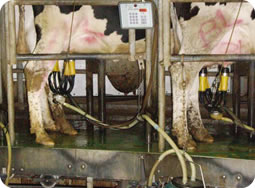
Risks of feeding dump milk to calves
Replacement heifer calves represent the future of your dairy herd. This guide provides information and guidance for you to make decisions on how best to feed these valuable animals.Feeding dump milk (mastitic, high cell count or antibiotic contaminated milk) is an attractive option for many farmers as it can be seen as a 'free' calf feed. Unfortunately this option carries certain risks:
- Calves fed 'dump' milk have been shown to have higher mortality rates than those fed on either milk replacer or 'whole' milk (not mastitic or containing antibiotics)
- Feeding antibiotic contaminated milk to calves can promote the development of antimicrobial resistant strains of bacteria
- Feeding dump milk can transfer infectious diseases like Johne's Disease, which causes weight loss, reduced production and premature culling
- Mastitis-causing bacteria present in dump milk can be transmitted from heifers mouths to udders by cross-suckling or grooming, resulting in blind quarters or mastitis at first calving
Options which can minimise risk if you decide to feed dump milk to calves:
- Before using as a calf feed, pasteurise waste milk to reduce microbial load
- Do not feed waste milk to newborn calves 1–2 days old, due to permeability of gut lining
- House heifer calves individually (for example, hutches) when feeding waste milk
- Know the health status of the cows from which waste milk is obtained. Unless milk is pasteurised, do not feed milk from cows shedding BVD or Johne's or from cows infected with E. coli
- Don't allow waste milk to sit for an extended time without refrigeration
- Discard waste milk that is bloody, watery or unusual in appearance

Farmers Guides
- Optimising the milking routine
- Basic mastitis types and control
- Probability of cure following intramammary antibiotic treatment
- Improving udder health around
drying off - Udder Examination
- California Mastitis Test
- Technique for infusion of a combination of dry cow antibiotic and OrbeSeal®
- Sterile milk sampling for bacteriology
- Collecting and transporting samples
- Risks of feeding dump milk to calves

